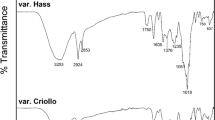Abstract
Viburnum opulus is a plant with fruits that are rich in biologically active substances, making it valuable to the food and pharmaceutical industries. Here, we present our study of the total phenolic and anthocyanin contents and antimicrobial activity in the fruit juice of six V. opulus L. accessions. The cultivar ‘Krasnaya Grozd’ was notable for its exceptionally large amount of total phenolics, 1168 mg/100 g, with anthocyanins comprising 3–5 % of the total phenolic content. The evaluation of the antimicrobial properties confirmed that the juice of V. opulus fruits strongly inhibited the growth of a wide range of human pathogenic bacteria, both Gram-negative (Salmonella typhimurium and S. agona) and Gram-positive (Staphylococcus aureus, Lysteria monocytogenes, and Enterococcus faecalis) organisms. Conversely, the yeasts Debaryomyces hansenii and Torulaspora delbrueckii showed complete resistance to the fruit juice, whereas a low sensitivity was demonstrated by Trichosporon cutaneum, Kluyveromyces marxianus var. lactis, Saccharomyces cerevisiae, S. cerevisiae 12R, and Candida parapsilosis.
Similar content being viewed by others
References
Osipova I (2001) Allelopathic properties of European cranberry bush (Viburnum opulus L.) - valuable decorative, medicinal and fruit plant, In: P.Salaš (Ed.), Proceedings of 9th International Conference of Horticulture, Lednice, Czech Republic, September 3–6, pp 146–152
Velioglu YS, Ekici L, Poyrazoglu ES (2006) Phenolic composition of European cranberrybush (Viburnum opulus L.) berries and astringency removal of its commercial juice. Int J Food Sci Tech 41:1011–1015
Van Q, Nay BN, Reimer M, Jones PJH, Fulcher RG, Rempel CB (2009) Anti-inflamatory effect of Inonotus obliquus, Polygala senega, and Viburnum trilobum in a cell screening assay. J Ethnopharmacol 125:487–493
Zayachkivska OS, Gzegotsky MR, Terletska OI, Lutsyk DA, Yaschenko AM, Dzhura OR (2006) Influence of Viburnum opulus proanthocyanins on stress induced gastrointestinal mucosal damage. J Physiol Pharmacol 57(5):155–167
Deineka VI, Sorokopudov VN, Deineka LA, Shaposhnik EI, Kol’tsov SV (2005) Anthocyans from fruit of some plants of the Caprifoliaceae family. Chem Nat Compd 41(2):162–164
Turek S, Cisowski W (2007) Free and chemically bonded phenolic acids in barks of Viburnum opulus L. and Sambucus nigra L. Acta Pol Pharm 64(4):377–383
Burns Kraft TF, Dey M, Rogers RB, Ribnicky DM, Gipp DM, Cefalu WT, Raskin I, Lila MA (2008) Phytochemical composition and metabolic performance-enhancing activity of dietary berries traditionally used by native North American. J Agric Food Chem 56(3):654–660
Rop O, Reznicek V, Valsikova M, Jurikova T, Mlcek J, Kramarova D (2010) Antioxidant properties of European cranberrybush fruit (Viburnum opulus var. edule). Molecules 15(6):4467–4477
Jordheim M, Giske NH, Andersen ØM (2007) Anthocyanins in Caprifoliaceae. Biochem Syst Ecol 35(3):153–159
Cavanagh HMA, Hipwell M, Wilkinson JM (2003) Antibacterial activity of berry fruits used for culinary purposes. J Med Food 6(1):57–61
Rauha JP, Remes S, Heinonen M, Hopia A, Kähkönen M, Kujala T, Pihlaja K, Vuorela H, Vuorela P (2000) Antimicrobial effect of Finnish plant extracts containing flavonoids and other phenolic componds. Int J Food Microbiol 56:3–12
Magariños HLE, Sahr C, Selaive SDC, Costa ME, Figuerola FE, Pizarro OA (2008) In vitro inhibitory effect of cranberry (Vaccinium macrocarpum Ait.) Juice on pathogenic microorganisms. Appl Biochem Microbiol 44(3):300–304
Puupponen-Pimiä R, Nohynek L, Alakomi HL, Oksman-Caldentey KM (2005) Bioactive berry compounds—Novel tools against human pathogens. Appl Microbiol Biotechnol 67:8–18
Paredes-López O, Cervantes-Ceja ML, Vigna-Pérez M, Hernández-Pérez T (2010) Berries: Improving human health and healthy aging, and promoting quality life – A review. Plant Foods Hum Nutr 65:299–308
Viškelis P, Rubinskienė M, Jasutienė I, Šarkinas A, Daubaras R, Česonienė L (2009) Anthocyanins, antioxidative, and antimicrobial properties of American cranberry (Vaccinium macrocarpon Ait.) and their press cakes. J Food Sci 74(2):C157–C161
Sagdic O, Aksoy A, Ozkan G (2006) Evaluation of the antibacterial and antioxidant potentials of cranberry (gilaburu, Viburnum opulus L.) fruit extract. Acta Aliment 35(4):487–492
Slinkard K, Singleton VL (1977) Total phenol analysis: automation and comparison with manual methods. Am J Enol Vitic 28:49–55
Rubinskiene M, Speiciene V, Leskauskaite D, Viskelis P (2007) Effect of black currant genotype on the quality and rheological properties of jams. J Food Agric Environ 5(1):71–75
Giusti MM, Wrolstad RE, Wrolstad RE, Acree TE, An H, Decker EA, Penner MH, Reid DS, Schwartz SJ et al (2001) Characterization and measurement of anthocyanins by UV–visible spectroscopy. In: Current protocols in food analytical chemistry. John Wiley & Sons, Inc, New York
Egea I, Sánchez-Bel P, Romojaro F, Pretel MT (2010) Six edible wild fruits as potential antioxidant additives or nutritional supplements. Plant Foods Hum Nutr 65:121–129
Szajdek A, Borowska EJ (2008) Bioactive compounds and health promoting properties of berry fruits. Plant Foods Hum Nutr 63:147–156
Karimova AR, Yunusova SG, Galkin EG, Fedorov NI, Yunusov MS (2004) Lipids and lipophilic components of Viburnum opulus fruits during maturation. Russ Chem Bull 53(1):245–250
Cam M, Hisl Y, Kuscu A (2007) Organic acid, phenolic content, and antioxidant capacity of fruit flesh and seed of Viburnum opulus. Chem Nat Compd 43(4):460–461
Česonienė L, Daubaras R, Venclovienė J, Viškelis P (2010) Biochemical and agro-biological diversity of Viburnum opulus genotypes. Cent Eur J Biol 5(6):864–871
Acknowledgement
This study was funded by Research Council of Lithuania, Grant No. SVE-04/2011.
Author information
Authors and Affiliations
Corresponding author
Rights and permissions
About this article
Cite this article
Česonienė, L., Daubaras, R., Viškelis, P. et al. Determination of the Total Phenolic and Anthocyanin Contents and Antimicrobial Activity of Viburnum Opulus Fruit Juice. Plant Foods Hum Nutr 67, 256–261 (2012). https://doi.org/10.1007/s11130-012-0303-3
Published:
Issue Date:
DOI: https://doi.org/10.1007/s11130-012-0303-3




